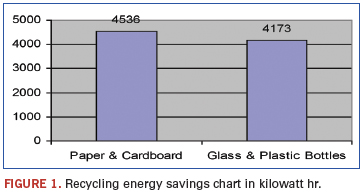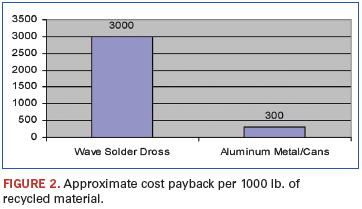Benefits of an EMS for the EMS
A well-conceived program can save money and materials.
Developing an EMS (Environmental Management System) can be beneficial to an electronics manufacturing services company. Benefits include monitoring and complying to regulatory requirements, setting and completing environmental objectives and pollution prevention. By setting either an objectives oriented program or a continuous improvement program, an organization can reduce costs and receive potential cost paybacks for activities such as recycling.
An EMS is a management system that creates processes to evaluate and control its environmental impacts and aspects, and comply with local, state and federal regulatory requirements. Many resources are available through state and federal environmental websites to develop an EMS. Upon development, certification can be achieved from the International Standards Organization (ISO).
Monitoring and compliance to regulatory requirements. The environmental regulations landscape continues to be very dynamic with state, local, federal (EPA) and electronics industry-related rules such as RoHS (Restriction of Hazardous Substances) and REACH (Registration, Evaluation, Authorization and Restriction of Chemicals). By setting up a system, a facility can monitor and comply with the constantly changing regulations in the US, Europe and the world.
The initial step is to catalog and make a list of the permits and reports, such as air release permit, water discharge, hazardous waste permits and reports, etc. Link the permit and report to the agency and regulation that governs the requirement. Upon making the list, verify the regulatory requirements. This can be accomplished by reviewing the requirement on the state or federal website (epa.gov) or by attending workshops. The EPA provides training on such matters as TRI (Toxic Release Inventory) compliance. This workshop helps businesses prepare the TRI report, which contains a facility’s evaluation of its materials handling and determination if a release threshold has been surpassed. As an example, for EMS companies, if 100 lb. of lead solder is used and released to the environment by offsite storage (manifested hazardous waste) or through recycling activities, a report must be completed and submitted to the EPA and state. Global environmental regulation updates can be received differently; workshops are available through trade organizations or by electronic update exchanges.
As a part of the compliance system, a review can be conducted of what was learned or changed and how it impacts the manufacturing facility. This review or audit can be completed after each workshop or on a yearly basis.
Environmental objectives and pollution prevention. Reducing facility impacts to the environment can be achieved by deploying an environmental objectives program. Examples of environmental impacts include release to air, water and soil and are usually regulated by the facility’s environmental permits and reports. This program can be incorporated into existing quality improvement or Lean manufacturing processes. Consider pollution prevention, waste minimization and green design when incorporating new processes, products or materials. A major component of an effective objectives program is recycling.
Recycling opportunities. Many opportunities exist to recycle within an EMS company. The foundation of recycling begins with glass, plastic bottles, paper products and cardboard. The recycling of printed circuit assemblies, subassemblies, mechanical hardware, components and solder may result in a payback for the metals extracted and refined. Diligence is required before deeming the material recyclable, given hazardous substances and state and federal regulations. Recyclers will shred the item and extract the metals such as tin, copper, silver, etc., which, given current metal prices, may provide a cost payback. Solder dross (lead and lead-free) is one example of material that can be recycled, given its characteristics and metal content. Other opportunities include computer equipment, printers, packaging materials and scrap metal, such as piping, tooling and fixtures.
Reuse of packaging and handling materials. In many cases, the best recycling approach is to reuse the item. This can be best accomplished with packaging and handling materials. Cases may surface in which the packaging material is not recyclable; this may result in a redesign to recyclable material or reusable packaging. Upfront design will be needed for this determination, ideally before product introduction.
Figure 1 can be used to calculate energy savings for the recycling activities at the EMS facility. The metric is calculated on the assumption that recycling saves energy verses the total manufacturing process of creating new material. In the example below, the kilowatt per hour (KWH) savings was based on one ton of paper, cardboard, glass and plastic bottles recycled.

The combined total energy saved is equal to approximately the average household energy use for one full year. Calculators are available through state and federal (EPA) environmental departments and websites.
Other opportunities for projects include energy reduction through lighting and motor improvements and chemical, waste and material reductions. In most cases, energy objectives can result in a cost reduction, usually by modifying lighting times and upgrading lighting fixtures and motors to energy-efficient equivalents. It is important to understand the simple payback of the project; on occasion, rebates are available that can be factored into the calculation.
Potential cost and environmental payback. In addition to the benefits of completing environmental objectives and pollution prevention, cost reductions and paybacks can be potentially received. Electronics recycling, given the current market of metal pricing, provides a cost payback for scrap metal, subassemblies and wave solder dross. Figure 2 details an approximate cost payback per 1000 lb. of wave solder dross, aluminum cans and metal.
The biggest payback would be from the wave solder dross, which will be refined by the recycling supplier and associated metals (tin, copper, silver, etc.) extracted. Depending on market conditions, cardboard and paper recycling may also provide a payback. Some recycling activities will not result in a cost payback; the result will be the environmental benefit of the material not being discarded in a landfill.
Conclusion
The actions above can all benefit the environment. Moreover, EPA and state recognition and awards are available to successful companies. Employee involvement is important to any recycling program, given their knowledge of the process and products. Employees also have impacts on energy reduction, waste disposal and handling. A material or item that has been historically thrown away may be recycled or reused; employee involvement will bring attention to these new opportunities.
By setting up an environmental management system, a facility can monitor and comply with regulatory requirements and set up a program for environmental objectives and projects. In some cases, the results of the environmental project can provide a cost reduction or cost payback. By training and involving employees, many recycling ideas will surface to the benefit of the environment and manufacturing facility.
Scott Mazur is a manufacturing staff engineer and environmental management representative for Benchmark Electronics (bench.com); scott.mazur@bench.com.
References
1. Scott Mazur, “Environmental Recycling for the EMS” – SMT, October 2010.
2. Scott Mazur, “Developing an Environmental Management System for the Electronics Manufacturer,” IMAPS New England Symposium, May 2011.




